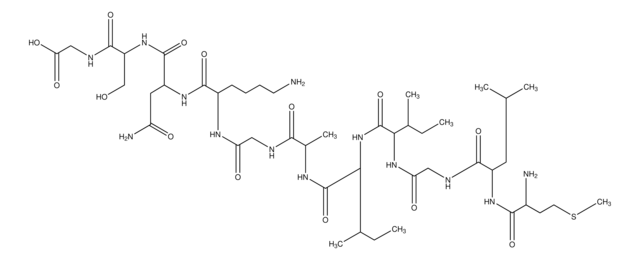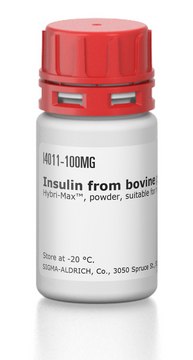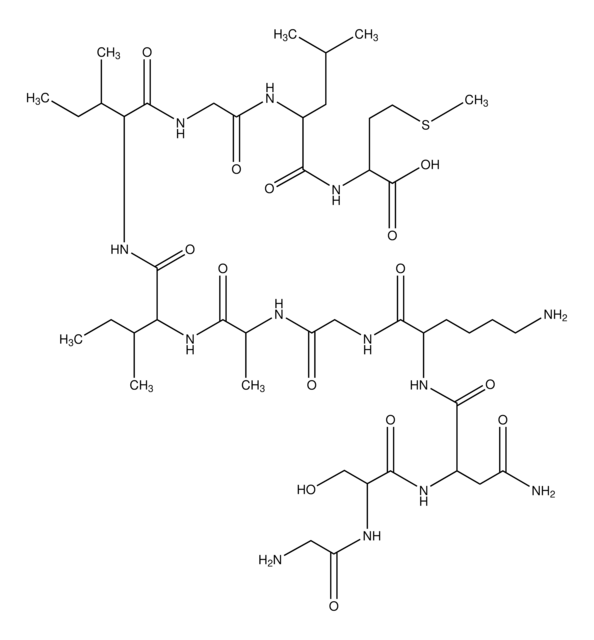All Photos(1)
Empirical Formula (Hill Notation):
C84H119N27O28
Molecular Weight:
1955.01
UNSPSC Code:
12352209
NACRES:
NA.32
Recommended Products
Assay
≥95% (HPLC)
form
lyophilized
composition
Peptide Content, ≥70%
storage condition
protect from light
storage temp.
−20°C
Amino Acid Sequence
Asp-Ala-Glu-Phe-Arg-His-Asp-Ser-Gly-Tyr-Glu-Val-His-His-Gln-Lys
Application
Amyloid β (Aβ) refers to peptides derived from Amyloid precursor protein that vary in length from 36-43 amino acids. Aβ(s) peptides, their peptide fragments and mutated fragments are used to study a wide range of metabolic and regulatory functions including activation of kinases, regulation of cholesterol transport, function as a transcription factor, and regulators of inflammation. Aβ(s) peptides and their peptide fragments are also used to study oxidative stress, metal binding and mechanisms of protein cross-linking in the context of diseases such as Alzheimer′s disease and neurodegeneration.
WGK
WGK 3
Flash Point(F)
Not applicable
Flash Point(C)
Not applicable
Regulatory Information
常规特殊物品
Certificates of Analysis (COA)
Search for Certificates of Analysis (COA) by entering the products Lot/Batch Number. Lot and Batch Numbers can be found on a product’s label following the words ‘Lot’ or ‘Batch’.
Already Own This Product?
Find documentation for the products that you have recently purchased in the Document Library.
Youssef El Khoury et al.
The journal of physical chemistry. B, 115(49), 14812-14821 (2011-10-27)
Alzheimer's disease is a neurodegenerative disorder in which the formation of amyloid-β (Aβ) aggregates plays a causative role. There is ample evidence that Cu(II) can bind to Aβ and modulate its aggregation. Moreover, Cu(II) bound to Aβ might be involved
Craig S Atwood et al.
Brain research. Brain research reviews, 43(1), 1-16 (2003-09-23)
Although much maligned, the amyloid-beta (Abeta) protein has been shown to possess a number of trophic properties that emanate from the protein's ability to bind Cu, Fe and Zn. Abeta belongs to a group of proteins that capture redox metal
Antonio Verdoliva et al.
Human vaccines, 6(11), 936-947 (2010-10-29)
Over the past few years, new ways of fighting Alzheimer's disease have emerged based on stimulating the immunitary defence system of the patients. To avoid toxicity and autoimmune response related to the Aβ[1-42] peptide immunotherapy, in the last decade a
Our team of scientists has experience in all areas of research including Life Science, Material Science, Chemical Synthesis, Chromatography, Analytical and many others.
Contact Technical Service




